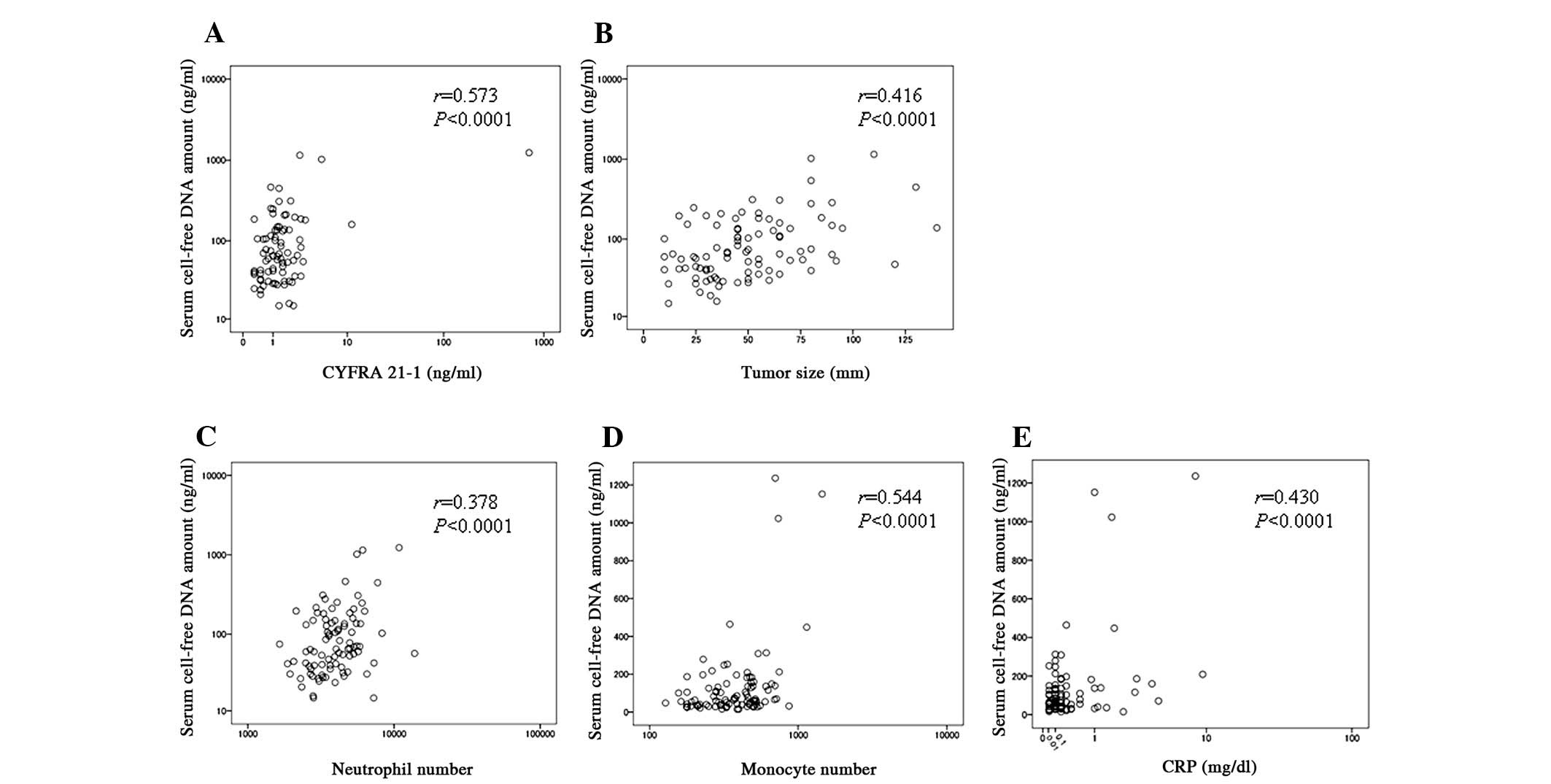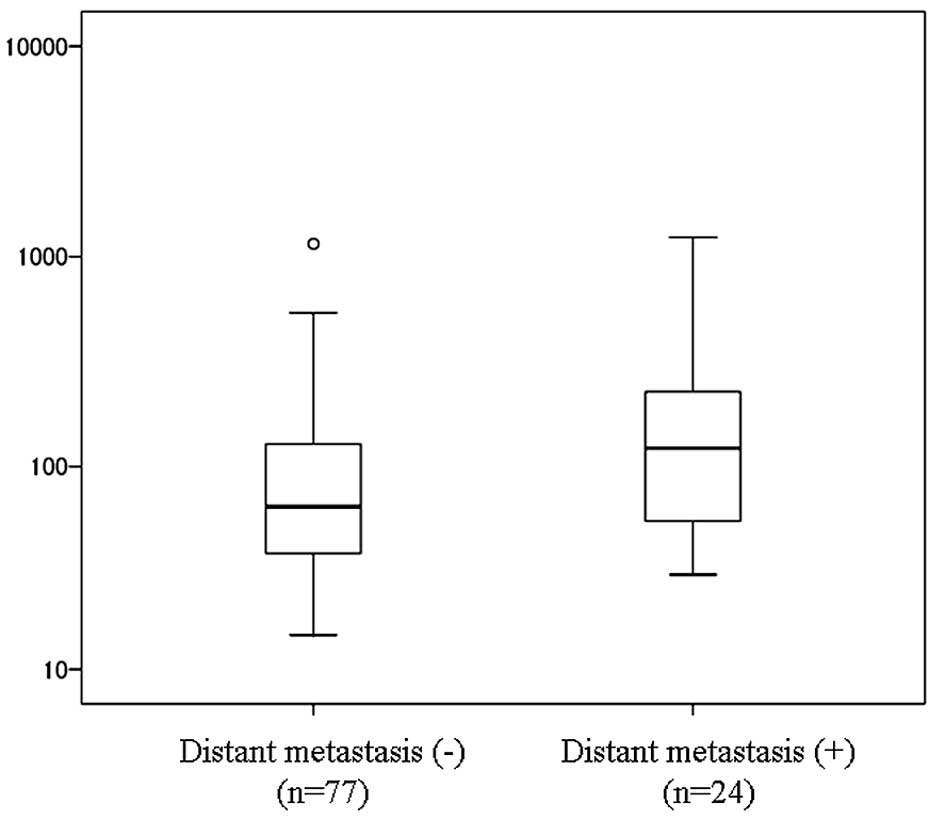|
1.
|
Parkin DM, Bray F, Ferlay J and Pisani P:
Global cancer statistics. CA Cancer J Clin. 55:74–108. 2005.
View Article : Google Scholar
|
|
2.
|
Enzinger PC and Mayer RJ: Esophageal
cancer. N Engl J Med. 349:2241–2252. 2003. View Article : Google Scholar : PubMed/NCBI
|
|
3.
|
Oka M, Yamamoto K, Takahashi M, Hakozaki
M, Abe T, Iizuka N, Hazama S, Hirazawa K, Hayashi H, Tangoku A,
Hirose K, Ishihara T and Suzuki T: Relationship between serum
levels of interleukin 6, various disease parameters and
malnutrition in patients with esophageal squamous cell carcinoma.
Cancer Res. 56:2776–2780. 1996.PubMed/NCBI
|
|
4.
|
Iizuka N, Hirose K, Noma T, Hazama S,
Tangoku A, Hayashi H, Abe T, Yamamoto K and Oka M: The nm23-H1 gene
as a predictor of sensitivity to chemotherapeutic agents in
oesophageal squamous cell carcinoma. Br J Cancer. 81:469–475. 1999.
View Article : Google Scholar : PubMed/NCBI
|
|
5.
|
Ishikura S, Nihei K, Ohtsu A, Boku N,
Hironaka S, Mera K, Muto M, Ogino T and Yoshida S: Long-term
toxicity after definitive chemoradiotherapy for squamous cell
carcinoma of the thoracic esophagus. J Clin Oncol. 21:2697–2702.
2003. View Article : Google Scholar : PubMed/NCBI
|
|
6.
|
Kleinberg L and Forastiere AA:
Chemoradiation in the management of esophageal cancer. J Clin
Oncol. 25:4110–4117. 2007. View Article : Google Scholar : PubMed/NCBI
|
|
7.
|
Chen G, Wang Z, Liu XY, Zhang MY and Liu
FY: Abdominal lymph node metastasis in patients with mid thoracic
esophageal squamous cell carcinoma. World J Surg. 33:278–283. 2009.
View Article : Google Scholar : PubMed/NCBI
|
|
8.
|
Shimada H, Okazumi S, Matsubara H, Nabeya
Y, Shiratori T, Shimizu T, Shuto K, Hayashi H and Ochiai T: Impact
of the number and extent of positive lymph nodes in 200 patients
with thoracic esophageal squamous cell carcinoma after three-field
lymph node dissection. World J Surg. 30:1441–1449. 2006. View Article : Google Scholar : PubMed/NCBI
|
|
9.
|
Montesano R, Hollstein M and Hainaut P:
Genetic alterations in esophageal cancer and their relevance to
etiology and pathogenesis: a review. Int J Cancer. 3:225–235. 1996.
View Article : Google Scholar : PubMed/NCBI
|
|
10.
|
Parkin DM, Bray F, Ferlay J and Pisani P:
Estimating the world cancer burden: Globocan 2000. Int J Cancer.
94:153–156. 2001. View
Article : Google Scholar : PubMed/NCBI
|
|
11.
|
Gautschi O, Bigosch C, Huegli B, Jermann
M, Marx A, Chasse E, Ratschiller D, Weder W, Joerger M, Betticher
DC, Stahel RA and Ziegler A: Circulating deoxyribonucleic acid as
prognostic marker in non-small cell lung cancer patients undergoing
chemotherapy. J Clin Oncol. 22:4157–4164. 2004. View Article : Google Scholar : PubMed/NCBI
|
|
12.
|
Tokuhisa Y, Iizuka N, Sakaida I, Moribe T,
Fujita N, Miura T, Tamatsukuri S, Ishitsuka H, Uchida K, Terai S,
Sakamoto K, Tamesa T and Oka M: Circulating cell-free DNA as a
predictive marker for distant metastasis of hepatitis C
virus-related hepatocellular carcinoma. Br J Cancer. 97:1399–1403.
2007. View Article : Google Scholar : PubMed/NCBI
|
|
13.
|
Umetani N, Giuliano AE, Hiramatsu SH,
Amersi F, Nakagawa T, Martino S and Hoon DS: Prediction of breast
tumor progression by integrity of free circulating DNA in serum. J
Clin Oncol. 24:4270–4276. 2006. View Article : Google Scholar : PubMed/NCBI
|
|
14.
|
Tomita H, Ichikawa D, Ikoma D, Sai S, Tani
N, Ikoma H, Fujiwara H, Kikuchi S, Okamoto K, Ochiai T and Otsuji
E: Quantification of circulating plasma DNA fragments as tumor
markers in patients with esophageal cancer. Anticancer Res.
27:2737–2741. 2007.
|
|
15.
|
Sobin LH and Wittekind C: TNM
Classification of Malignant Tumours. 6th edition. UICC, Wiley-Liss;
pp. 81–83. 2002
|
|
16.
|
Iizuka N, Sakaida I, Moribe T, Fujita N,
Miura T, Stark M, Tamatsukuri S, Ishitsuka H, Uchida K, Terai S,
Sakamoto K, Tamesa T and Oka M: Elevated levels of circulating
cell-free DNA in the blood of patients with hepatitis C
virus-associated hepatocellular carcinoma. Anticancer Res.
26:4713–4719. 2006.PubMed/NCBI
|
|
17.
|
Balkwill F and Mantovani A: Inflammation
and cancer: back to Virchow? Lancet. 357:539–545. 2001. View Article : Google Scholar : PubMed/NCBI
|
|
18.
|
Iida M, Iizuka N, Sakaida I, Moribe T,
Fujita N, Miura T, Tamatsukuri S, Ishitsuka H, Uchida K, Terai S,
Tokuhisa Y, Sakamoto K, Tamesa T, Miyamoto T, Hamamoto Y and Oka M:
Relation between serum levels of cell-free DNA and inflammation
status in hepatitis C virus-related hepatocellular carcinoma. Oncol
Rep. 20:761–765. 2008.PubMed/NCBI
|
|
19.
|
Barak V, Goike H, Panaretakis KW and
Einarsson R: Clinical utility of cytokeratins as tumor markers.
Clin Biochem. 37:529–540. 2004. View Article : Google Scholar : PubMed/NCBI
|
|
20.
|
Yamamoto K, Oka M, Hayashi H, Tangoku A,
Gondo T and Suzuki T: CYFRA 21-1 is a useful marker for esophageal
squamous cell carcinoma. Cancer. 79:1647–1655. 1997. View Article : Google Scholar : PubMed/NCBI
|
|
21.
|
Brockmann JG, St Nottberg H, Glodny B,
Heinecke A and Senninger NJ: CYFRA 21-1 serum analysis in patients
with esophageal cancer. Clin Cancer Res. 6:4249–4252.
2000.PubMed/NCBI
|












